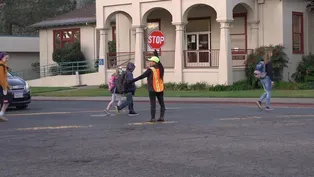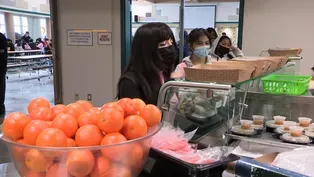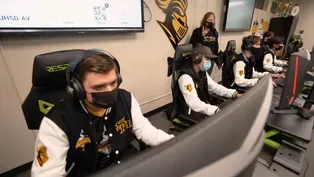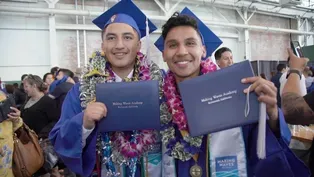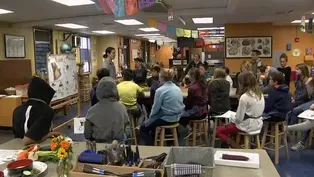Inside California Education
The Rise of E-Sports
Season 4 Episode 12 | 26m 46sVideo has Closed Captions
Meet an award-winning E-Sports team in Fullerton.
Meet an award-winning E-Sports team in Fullerton, and discover why this new sport is taking off in schools. Visit a farm in Fresno that is providing farm-to-fork food to local schools. Meet a Crossing Guard in Mendocino County with a passion for her job. Discover how one-on-one coaching is helping high schoolers in the Bay Area attain their college dreams.
Problems with Closed Captions? Closed Captioning Feedback
Problems with Closed Captions? Closed Captioning Feedback
Inside California Education is a local public television program presented by KVIE
Funding for the Inside California Education series is made possible by the California Lottery, SchoolsFirst Federal Credit Union, Stuart Foundation, ScholarShare 529, and Foundation for the Los Angeles Community Colleges.
Inside California Education
The Rise of E-Sports
Season 4 Episode 12 | 26m 46sVideo has Closed Captions
Meet an award-winning E-Sports team in Fullerton, and discover why this new sport is taking off in schools. Visit a farm in Fresno that is providing farm-to-fork food to local schools. Meet a Crossing Guard in Mendocino County with a passion for her job. Discover how one-on-one coaching is helping high schoolers in the Bay Area attain their college dreams.
Problems with Closed Captions? Closed Captioning Feedback
How to Watch Inside California Education
Inside California Education is available to stream on pbs.org and the free PBS App, available on iPhone, Apple TV, Android TV, Android smartphones, Amazon Fire TV, Amazon Fire Tablet, Roku, Samsung Smart TV, and Vizio.
Providing Support for PBS.org
Learn Moreabout PBS online sponsorshipAnnc: Coming up on Inside California Education: Meet an award-winning eSports team in Fullerton and see why gaming is quickly growing in popularity in California schools.
Ezra: I was already into PC gaming and some other gaming that I've done.
So, I saw that, and I got involved.
Annc: Visit a farm in Fresno that provides fresh food to local schools, as part of a new statewide effort to increase the amount of farm-to-fork foods available to students.
Amanda: You know, our students, they'’re... they're our customers, and they're demanding these things.
So, we're... we're giving our customers what they want.
Annc: Spend a day in the life of a crossing guard in Ukiah, who'’s passionate about protecting students and pedestrians.
Patty: It'’s great, great start to the morning.
I look forward to it every morning.
Annc: Explore a unique partnership at a Bay Area high school that provides resources and scholarships to help underrepresented youth go to college.
Carey: What we'’re hoping to do is to bring access to information, to provide those opportunities, because we know, over the course of a lifetime, what a college education does.
Annc: It'’s all next, on Inside California Education!
>>: Funding for Inside California Education is made possible by: At the California Lottery, we'’re focused on our mission to provide supplemental, essential funds to public schools - kinder through college.
Helping to keep teachers on staff, or pay for new school computers, band equipment, and other instructional materials and services.
Since 1985, we'’ve raised more than $37 billion.
And more than 95% of our sales go back to the community.
Music to all of our ears.
California Lottery - helping schools and communities across California.
The Stuart Foundation: Improving life outcomes for young people, through education.
ScholarShare 529: California'’s state-sponsored, tax-advantaged 529 college savings plan designed to help pay for the cost of higher education.
Additional funding for Inside California Education is made possible by these organizations supporting public education.
♪♪ ♪♪ Annc: If you think online video games are a far cry from the usual areas of study you'’d expect to see as part of a high school'’s curriculum, you may be surprised to learn that video gaming was recognized as an official sport in 2019, by the California Interscholastic Federation.
Since then, interest in eSports has taken off in high schools around the state.
Allen: Technology has integrated every aspect of high school, the way we teach, the way students learn.
Naturally, we want to not only use the technology but make students capable of pursuing career paths that involve the technology.
Annc: Allen Whitten is the principal of Sunny Hills High School in Fullerton, a school that'’s not only been honored as a "“California Distinguished School,"” but a school where video gaming is part of the focus on technology, and whose eSports team members have won national championships for their video gaming skills.
Cole: What I like about video games, especially, is that they offer this level of interactivity that something like a board game, or books, or movies just can't really, like, portray.
Annc: Sunny Hill'’s eSports club began in 2014.
Regular practice sessions allow young men and women to hone their gaming skills and vie for a spot on the school'’s competitive team- facing challengers online in local, regional, and national competitions.
Ezra: I saw the eSports club and it kind of intrigued me because I was already into PC gaming and some other gaming that I've done.
So, I saw that, and I got involved, um, and then my sophomore year, uh, I got even more involved and was the coach for one of the teams.
Myra: Can you play as an individual and as a team?
So, you could have an individual competition.
You could have a team competition.
Annc: Myra Deister is the eSports Club adviser and a computer science teacher at Sunny Hills.
She says students here compete in either one-on-one Smash Brothers gaming tournaments, or five-person League of Legends team play, where communication is critical.
Myra: They really need to be able to think ahead, as far as, "“Okay, what's going to be my next move?
What's going to be the best next move?
"” You have to be able to communicate well.
Communication skills, especially, because you need to be able to communicate with your teammates so that you can figure out how the team is going to do their next move.
Alexander: I think when you'’re like S tilting at the ledge, you could just turn around and do the 1, 2, 3, jab, and that would kill Alec 150, right?
Annc: Science Teacher Alexander Hua coaches students in the one-on-one Smash gaming competitions.
He brings a wealth of experience to the team, having competed, himself, in global gaming tournaments.
Team member Andres says the coaching input is critical to winning consistently.
Andres: Mr. Hua, my coach, he likes to point out things that I'm doing, or the opponent's doing, that's a habit and how I can improvise and how I can improve from that.
He makes me see things that I don't see.
I get to adapt, and it has worked multiple times when I was competing, when he coached me.
Alexander: Many students play games, uh, for fun, and I think with the academic side work, we're showing kids that not only can you play games for fun, but there are possibilities that this could also be a career, that there are jobs for people that have the same interests as these students.
Annc: Sunny Hills eSport team members have taken top honors in gaming competitions at both the state and national level- winning cash and trophies from the North American Scholastic ESports Federation.
Jack: So, construct three, you'’re going to basically create your characters, create the layouts, make the events, and make this into a functional game, and something that we'’re going to share with each other and be pretty fun, I think, to see what you guys come up with.
Annc: Instructor Jack Adams helps students create their own gaming scenarios while learning about computer coding.
The school sees eSports as an incentive, attracting students to traditional academic endeavors and furthering their interest in STEM courses: Science, Technology, Engineering, and Mathematics.
Cole: Our club is meant to not only appeal to the people who want the competition and who wants, you know, the glory, but also the more casual player base, the people who just want to hang out with friends Allen: Some kids are just, you know, gamers and love that aspect of it.
A lot of kids love computer science and learning the back end of the computer, building computers, learning how to code.
So, there's both of those, but at the end of the day, we're equipping them for whatever they're going to pursue.
You saw them in there when they're practicing, and they're playing with their teammates- the collaboration, the high-level problem solving, uh, the passion you see.
That... that's been really rewarding.
>>: Nice!
Annc: ESports is rapidly becoming a popular college sport.
In 2016, there were only 7 colleges offering varsity eSports teams.
Now, there are 170 colleges with more than 5,000 students playing eSports.
About $16 million in college scholarships and aid was offered to players, with typical scholarships ranging from $500 to $8,000 dollars a year.
Like traditional athletes, eSports players may go on to play professionally.
♪♪ Annc: Among the lunch items that students at Fresno high schools and middle schools can choose from is a hot chicken pho soup, made with local lemongrass.
The lemongrass is grown by Asian and Hmong farmers near Fresno, often, connecting the students'’ midday meal to their heritage.
Amanda: Fresno Unified, we have just a huge Hmong population- Fresno, in general- um, and... and so, the- Our students, their parents might work these fields.
They're, you know, they're... they're accustomed to these foods at home.
So, for them to see this in their lunch, it- they're more likely to participate and enjoy our meals.
Annc: Fresno Unified is the third largest school district in the state, with a food budget of $18 million.
They serve more than 55,000 lunches and 30,000 breakfasts, daily.
The school district wants to increase the amount of locally grown food it serves.
But many small farmers, especially immigrants, face obstacles to selling their fruits and vegetables to schools.
Keng: Even though the application is in English, you know, it's... it's still hard for a lot of our farmers to understand, uh, the process.
And then for our Hmong farmers, a lot of them don't speak English, so they don't understand- they can't even read or understand the... the English language.
So, we have to translate that for them, uh, help them on the way.
We're basically holding their hand throughout the whole process.
Annc: Keng Vang is with the Asian Business Institute and Resource Center.
They work with about 200 farmers in the Fresno area, helping them complete paperwork and overcome other challenges, in order to sell their products to school districts.
They'’re able to do so with a $250,000 grant they received as part of a new "Farm to School" initiative.
The Farm to School initiative started in California in 2021 with $8.5 million in grants to 60 schools, farmers, and other organizations.
That funding was increased to $60 million for grants in 2022 and 2023.
The effort is outlined in a new statewide report called "“Planting the Seed: A Farm to School Roadmap to Success in California.
"” It was spearheaded by First Partner Jennifer Newsom, and California'’s Secretary of Food and Agriculture, Karen Ross.
Karen: Six million meals a day are served in schools.
For way too many children, that's their sole source and maybe the most nutritious food that they get.
We know that of our 70,000 farms, over 56,000 of them are considered small, less than 500 acres.
And the vast majority, 50,000, are, average, about 119 acres.
So, if we could connect farms to school nutrition programs, and close that loop so that they could source more local, that would be a great thing.
Jennifer: Food is everything, and I want what I'm doing for my own kids to be available to every kid in California.
Annc: Jennifer Newsom recently toured a small farm in Fresno run by five Hmong farmers who have either sold their food to local schools, or hope to.
Afterwards, they explained many of the challenges they face when it comes to selling their produce to school districts.
Keng: There'’s a lot of hardships for us, for farmers, and I know there'’s hardships for the schools, too.
Jennifer: I've understood the sort of challenges and obstacles, but I think hearing them directly from the farmer really emphasize what... what we, as a state, and what we, as regional communities and school districts, are, um- need to work on.
And... and I do believe that we're headed in the right direction.
Michele: Fresno County is really unique in that we are the- one of the nation's most prolific producers of fresh produce and vegetables, yet we also have one of the highest levels of poverty.
We have 93 census tracks that are considered food deserts.
And that means that we really need to promote an interdependence, a respect, a relationship between our farmers and our students, so that they just understand that healthy lifestyle is so important.
Annc: This farmer, speaking through a translator, expressed his hope of becoming a vendor for Fresno schools because his herbs and vegetables are healthy options for kids.
[speaking foreign language] Xiong: The way we farm is organic-like.
Although we don't have organic certificate or license, uh, we do it organic-like because we feel like, uh, when we sell it to our consumers, we want them to eat safely.
Annc: The Farm to School grants are also available to schools to expand their own school gardens or farm programs, nonprofits, and other organizations working to increase access to fresh, local food for students.
Karen: Many of these were schools that were already embracing "farm to school."
They might've had a farm garden there on the premises, but they really wanted to expand that.
We have seen this over and over, when children are engaged, whether it's planting the seeds in the school garden, and then harvesting it and then preparing it, their interest in the food and... and trying different things just increases dramatically.
Michele: The Farm to Fork program is more of a social movement than even just a program, and it's about encouraging our students to take good care of themselves so that they can be successful and healthy in their lifetime.
Karen: When students are engaged at that level of starting at a very young age, their interest in food, and then understanding "What I put into my body will help me achieve better in the classroom, as well as on the sports field," they get excited about it.
Jennifer: We're living in a time with a lot of extremes, a lot of ini- income inequality, um, racial inequities and climate crises, and I think that what we can do here in California with our Farm to School programming is tackle all three, while also ensuring that our children are sound and healthy in mind and body by, again, feeding them the healthiest of food.
Annc: School nutrition teams serve nearly six million meals to California school kids every day.
During the pandemic, nearly one-quarter of all low-income California families relied on food from schools to cover shortages in their home.
Students, nationwide, participating in the National School Lunch Program and School Breakfast Program receive 47% of their daily calories from school meals.
These meals often serve as the kids'’ healthiest sources of fruits, vegetables, and other foods.
Annc: Still ahead on Inside California Education... Meet students at a Bay Area high school enrolled in a pilot program that provides them with scholarships, and a coach, to help them through their entire college experience.
Kristina: So, that one-on-one connection and that relationship that students build with their coaches really help them, you know, come into their own.
Annc: But first, we spent a day in the life with a school crossing guard, prior to the pandemic, as she navigates a busy street corner in Mendocino County.
♪♪ Patty: What gets me out of bed every morning is the thought of not being there saying "“Hello"” to everybody.
It doesn't matter if it's cold, hot, wind, rain, you still show up for work and you perform your job to the best of your ability and be happy doing it.
My name is Patty Dao.
I'm a crossing guard at Frank Zeek Elementary.
After the first time I substituted, I called my son saying, "Honey, I think I want to do this crossing guard."
It's great exercise and the people are great, children are great, and it felt great.
My daily schedule as a crossing guard begins at 7:00 AM.
Basically, I don my jacket, grab my sign, gloves on, and I head straight out to the corner.
We start the day with a great smile, positive attitude, and it just reflects on everybody.
It's great, great start to the morning.
I look forward to it every morning.
It's just like your cardio.
Beats joining the gym!
The intersection of Bush and Low Gap, that's my intersection.
It is so important to have a crossing guard at the location I'm at now.
It is really hectic and busy there, so having me there assures the safety of the children crossing; not only the children, but pedestrians and cars, alike, sometimes.
Patty: Nice out here, huh?
>>: Yeah, it is very nice, it's going to be a great day.
Patty: Beautiful.
>>: Have a good one.
Patty: You too, thank you.
My duties, I feel, are as important as a teacher's during school hours, but as a crossing guard, I see the children before and after school and I follow up on how their day is.
It's just as important because I really do follow up on them, "Have a great day," and again, we're leaving school, and I yell, "See you tomorrow!
I mean it!
Be here tomorrow, 'cause I'm going to be here tomorrow."
And they yell back, "See you tomorrow!"
I'm hardly gone.
I...
I would not miss work because I said I'll be here tomorrow.
I always know that they're happy to see me, and that's that peace of mind I think I help the parents with.
I can't tell you how that feels.
It just feels so good that you can make an impact on someone's day like that.
This is the place to be at, you know?
If you are considering a position as a crossing guard, first and foremost is your relationship to the children and the people and I think that makes a big, big impact on how you perform your duties.
Everyone here is just so supportive of it.
They're so happy.
They... they make me feel so appreciated and loved and valued for what you're doing out there.
It is just a great way to start the day, and I...
I...
I look forward to it.
♪♪ Annc: School crossing guards reduce the risk of pedestrian accidents by helping children safely cross the street during busy times of day.
Simply having the presence of a uniformed guard is a strong signal to drivers to slow down.
Crossing guards also model good behavior, teaching children the rules of the road and how to safely navigate crosswalks.
♪♪ Annc: Pittsburg High School, in the Bay Area'’s Contra Costa County, is a diverse campus of 3400 students.
75% of them come from families with incomes at, or below the poverty level.
Many are first generation residents in the U.S.
It may not surprise you that for many of these students, college feels more like an abstract idea than an option that could ever be available to them.
Todd: For many students, it'’s almost like it'’s like a mystery.
It'’s almost like a secret.
Annc: This high school is demystifying the experience by partnering with a nonprofit called Making Waves.
The foundation helps historically underserved youth attain higher education by providing them with the tools they need to get into college, and graduate with as little debt as possible.
Carey: What we'’re hoping to do is to bring access to information, to provide those opportunities, because we know over the course of a lifetime, what a college education does.
It not only improves the life of the individual who receives the degree, but multiple generations of that person'’s family are then on a track to excel as well.
Annc: That'’s what makes Anthony Gonzalez so hopeful and motivated to succeed.
He sees college as an opportunity for both him and his entire family.
Anthony was one of 18 students who graduated from Pittsburg High in 2021 as part of the first class in this pilot program.
Anthony: It makes me feel really honored to know that I'’m the first, like, wave of the Making Waves Foundation, here, at Pittsburgh High School, '‘cause I'’m, like, able to break that barrier, that many students don't have access to going to, um, college and obtaining that higher education.
Annc: The Making Waves Foundation offers workshops for all Pittsburg High students, covering college and financial aid planning.
Then, those who are interested can apply in their senior year to be part of the college and alumni program.
If accepted, it not only provides students with scholarships and planning tools, it also pairs them with a coach who guides them one-on-one through their entire college career.
Kristina: We talk about everything.
We talk about how to talk to your roommates, how to navigate, um, talking to your professor.
Really looking at their finances.
How do you build a budget?
How do you manage your... your scholarship funds and really live on campus, away from home, for the first time ever?
Do you have your resume already built out?
Anthony: Um, no, I'’m still working on that...
So, that coach is there to help you, not only academically, but like physic- check up on you physically, mentally, and just provides you with, like, life-changing tips, lessons.
Kristina: ...and then you'’re gonna use that to apply for that internship opportunity.
Anthony: Okay, sounds good.
Kristina: Awesome!
The one-on-one piece is so important because trust is so important in this process.
Um, it can be embarrassing to ask questions and to not have the answers that you think all of your peers have.
Annc: Dr. Kristina Wright has coached hundreds of students in her 20 years with the Making Waves Foundation.
She says the one-on-one coaching is as instrumental to their program as their focus on financial literacy.
Kristina: We really built in the financial literacy piece with students because we want them to be knowledgeable about the decisions that they're making from the time they make a choice about which college they want to go to, to which credit card they want to get, to their first car.
Annc: Principal Todd Whitmire says the expense of college and not knowing how to find funding is what prevents many of his students from even trying.
Todd: "How do I pay for, um, college application fees?"
or "How do I pay for the SAT?"
While those may seem like relatively insignificant hurdles to you and I, the reality is for many students, that might be a showstopper.
Annc: As for Anthony Gonzalez, he'’s now at U.C.
Davis.
Anthony says the support and scholarship he'’s received is helping provide a path that he hopes his younger brother, Manuel, will follow.
Manuel is now creating plans for himself that he wouldn'’t have dreamt of, not too long ago.
Anthony: Coming from a low-income family and undocumented parents, it'’s like i- in a way, through this scholarship, I'’m able to, um, honor their sacrifices and legacy in coming in search for the American dream.
Annc: For Kristina Wright, these success stories fuel her passion, and remind her of her own childhood experiences.
Kristina: In my work with them, they've inspired me so much to keep going, uh, to keep pursuing higher education opportunities and then, to ultimately get that doctorate, to show them that people from our community are able, you know, to go out and do these things.
Annc: Making Waves hopes to expand this program to other high schools in Contra Costa County, giving students the tools, knowledge, and support to realize their collegiate dreams.
The hope is that those achievements will change the life trajectory of not just these students, but the many generations that follow.
Carey: Our hope is to be that partner, to schools and districts, to teachers and counselors, parents and families, to make sure that all are on the same level playing field, to make sure that their student can have the successful outcomes in life that they deserve.
Annc: Research shows that students who are the first in their family to go to college are more likely to incur debt for their education and are less likely to complete a bachelor'’s degree.
Earning a college degree has a significant impact on the next generation, as the children of college graduates are more likely to attend a four-year institution, earn higher incomes, and graduate from college with less debt.
That'’s it for this edition of Inside California Education.
If you'’d like more information about the program, log on to our website: insidecaled.org.
We have videos from all of our shows, and you can connect with us on social media.
Thanks for joining us.
We'’ll see you next time on Inside California Education.
>>: Funding for Inside California Education is made possible by: At the California Lottery, we'’re focused on our mission to provide supplemental, essential funds to public schools - kinder through college.
Helping to keep teachers on staff, or pay for new school computers, band equipment, and other instructional materials and services.
Since 1985, we'’ve raised more than $37 billion.
And more than 95% of our sales go back to the community.
Music to all of our ears.
California Lottery - helping schools and communities across California.
The Stuart Foundation: Improving life outcomes for young people, through education.
ScholarShare 529: California'’s state-sponsored, tax-advantaged 529 college savings plan designed to help pay for the cost of higher education.
Additional funding for Inside California Education is made possible by these organizations supporting public education.
Day in the Life – Crossing Guard
Video has Closed Captions
Clip: S4 Ep12 | 3m 31s | Meet a Crossing Guard in Mendocino County with a passion for her job helping students. (3m 31s)
Farm-to-School – Growing Food for Schools
Video has Closed Captions
Clip: S4 Ep12 | 6m 44s | Learn about the new Farm-to-School movement in Fresno. (6m 44s)
The Gamer Generation – The Rise of E-Sports
Video has Closed Captions
Clip: S4 Ep12 | 5m 41s | Meet an award-winning E-Sports team in Fullerton. (5m 41s)
Making Waves – Reaching a College Dream
Video has Closed Captions
Clip: S4 Ep12 | 6m 9s | Discover how one-on-one coaching is helping high schoolers reach their college dreams. (6m 9s)
Preview: S4 Ep12 | 30s | Meet an award-winning E-Sports team and discover a new Farm-to-School movement. (30s)
Providing Support for PBS.org
Learn Moreabout PBS online sponsorshipSupport for PBS provided by:
Inside California Education is a local public television program presented by KVIE
Funding for the Inside California Education series is made possible by the California Lottery, SchoolsFirst Federal Credit Union, Stuart Foundation, ScholarShare 529, and Foundation for the Los Angeles Community Colleges.
